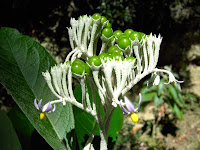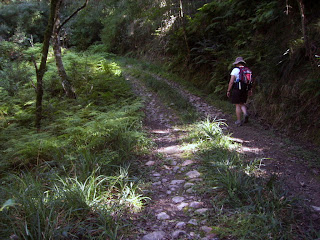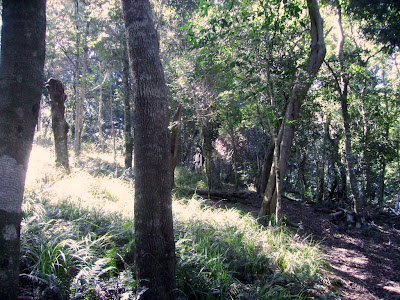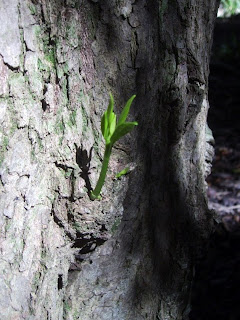 Date: 20 March 2009
Date: 20 March 2009Location: Grootvadersbosch Nature Reserve, near Heidelberg (and about forty minute's drive from Swellendam). Map here.
Walkers: Ian, John, Dorothy and Helen
(Photo by Helen)
This was a first visit for all of us to the Grootvadersbosch Nature Reserve in the Langeberg mountains. It is known for its large indigenous forest.
From the entrance/office area we could see the peaks of the mountains in the adjoining reverse (Boosmansbos Wilderness Area). Maps were consulted as we decided on a route for our day-walk.


(Photos by Helen)
We set out down into the forest on the Bushbuck Trail, which comprises various loops and circuits.


(Photos by Helen)
The Melkhoutpad which was an easy stroll.

(Photo by John)
We stopped at the bird hide. There weren't many birds around at this time of day but we got lovely views of the forest in the valley and the mountains.




(Photos by Helen) (Photos by John)
We were curious about a leafy bush with bright green berries that ripened to a deep red. We were sure this isn't an indigenous plant. What it is?



(Photo by Dorothy) (Photos by John)
Next we spotted an even stranger plant, growing on the ground. It looked like it could be a type of fungus. It had a stinky smell. John reckoned this was "jakkalskos": Hydnora Africana. Update: Misidentification! I think this is actually a fungus from Australia called Aseroe rubra.

(Photo by Helen)
Melkhoutpad led us on further down, with occasional glimpses of the view beyond between the trees and bushes.

(Photo by John)
Next we left the road and went down into the forest proper. We crossed over the Duivenhoks River, which we know so well further downstream, at Vermaaklikheid. It did not look very impressive here!


(Photo by Dorothy) (Photo by Helen)
Joining the Stinkhoutsirkel loop of the Bushbuck Trail, we chose to make a detour to see the redwoods before continuing on. The path led through much ferny undergrowth.




(Photo by Dorothy) (Photos by Helen) (Photo by John)
This was such beautiful forest!

(Photo by John)
And suddenly, around a bend, we came to the Californian redwoods. These trees, as well as other exotics, were planted in the early 1900s after woodcutters cleared the indigenous trees. CapeNature are in the process of reclaiming the area, so we were lucky to see these trees before they go.

(Photo by Helen)
They were truly impressively tall!


(Photo by Helen) (Photo by Dorothy)
The bark was thick, soft and fibrous, and the leaves and cones surprisingly small. It was quiet - almost hushed - beneath these giant trees.



(Photos by Dorothy) (Photo by Helen)
We doubled-back to Stinkhoutsirkel, and made our way through forest of more familiar trees, like yellowwoods and stinkwoods, and newly identified ones (thanks, Ian!) like saffraans and scolopias - all indigenous.

(Photo by Helen)
Also, there was much to see in the forest other than trees: unusual fungi, ferns, grasses, lichens, moss, new shoots...






(Photos by Helen) (Photos by John)
Continuing next along the Bosbokrand path, we passed a stand of other exotic trees that had died after being ring-barked, and were now ready to be cleared from the forest.

(Photo by John)
A snack was had on some mossy boulders.


(Photos by John)
Our next stop was at a second bird hide. This one was three storeys high!




(Photos by Helen) (Photo by John)
We ambled up through the last stretch of forest...

(Photo by John)
... through more leafy shrubbery...


(Photos by Helen)
... and back out onto the road!

(Photo by Helen)
From here it was back to our cars at the office. We had lunch in the shade of the thatched lapa at the campsite, and rested in the shade for a while.


(Photos by Helen)
Later, we set off for a second walk. This time we did a small section of the Grysbok Trail, setting off in the same direction as before, but walking out past the forest and onto the hill. When we looked back we could see the entrance, office and camping area.

(Photo by Helen)
It was good to walk in the warm sunshine! The vegetation on this stretch was transitional (a mix of forest and fynbos).

(Photo by Helen)
Here we saw pink erica and pink keurboom (Virgilai Orobiodes) in flower.


(Photos by Helen)
Dorothy and John showing off their new walking sticks, and the famous three-quarter profile pose!


(Photos by Helen)
Next it was back down into the forest, to the waterfall off the Fonteintjiesbos path. Once we left the road it was a steep climb down a zig-zag path. The waterfall at the bottom was almost dry.




(Photo by Helen) (Photos by John)
We then climbed back up, and made our way back to the cars along forest roads. We loved the forests at Grootvadersbosch, but there's so much more to explore, we'll have to visit again.
.








2 comments:
Seems to be lovely down there!
You asked about red berries found in marsh 2009!
They must belong to the Solanum-genera. That means that You shold never try to eat them even if they look like small tomatoes! If You don't have knowledge telling the opposite -- like real tomatoes. The plant resembels S.schumannianum in E Africa verry much = same sub-genera (?)
Claes in the North.
Thanks for the info Claes.
Post a Comment